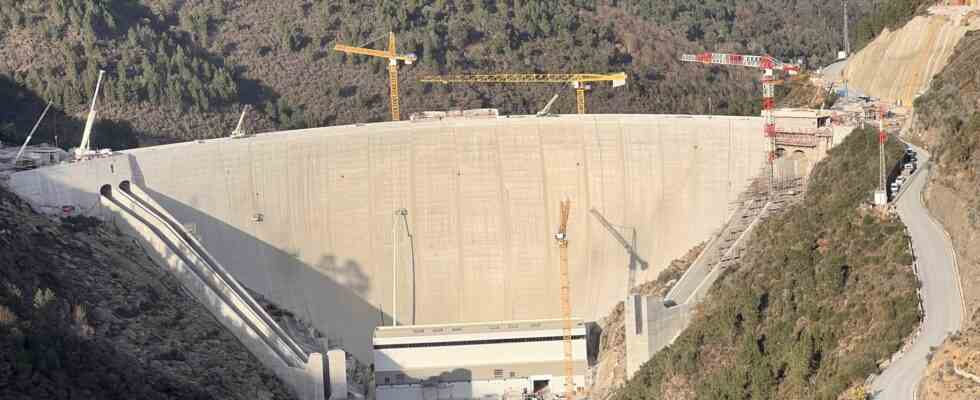Status: 02/26/2023 03:19 am
In a few years, Portugal wants to cover 80 percent of its electricity from renewable energies. But what if the sun doesn’t shine or there’s no wind? Then a gigantic pumped storage power plant can help.
The Tâmega River in the scrubby, pine-covered north of Portugal is one of the main characters in this story. It is about how green electricity can be reliably fed into the grid when it is needed – i.e. regardless of whether wind and solar energy are available at the time or not.
The new pumped storage power plant in Portugal
Sebastian Kisters, ARD Madrid, 2/22/2023 5:35 p.m
Reservoir as an energy reserve
Below a reservoir, above a reservoir, in between almost eight kilometers of underground tunnels that engineers from the Spanish energy company Iberdrola have driven into the mountainside. The upper reservoir collects water that was pumped up from the lower reservoir, explains civil engineer Rafael Chacón. This is saved in order to be able to generate green electricity on demand.
The water in the upper reservoir is constantly in motion: sometimes the level rises, sometimes it falls. The higher it is, the more energy is stored in the system. “Like a gigantic battery,” explains Chacón. If the Portuguese electricity grid needs more energy, it will be generated with the water from this upper reservoir. If there is excess energy in the system, for example on particularly windy days, the water is pumped up from the lower reservoir and stored in the upper reservoir.
Water and gravity make it possible. The upper reservoir has a capacity of 40 cubic meters, i.e. 40,000 liters of water. Should the wind and sun fail completely, the power requirements of the greater Porto area could be covered for 24 hours, says Iberdrola – after all, the second largest city in the country. For comparison: The gigantic pumped storage power plant “Nant de Drance”, in the Valais Alps in the border area between Switzerland and France, could supply electricity for 20 hours before the reservoir there was empty.
Heart deep in the mountainside
The heart of this Portuguese pumped storage power plant is located deep in a mountain slope. Tunnels lead to a huge cavern, it’s loud. There are four large pump turbines here. Three of them loudly pump water from the lower to the upper reservoir.
Chacón explains what is special about it: the pumped storage power plant can switch between pump and power generation modes at any time, as required. Times of low power consumption are used to fill up the upper reservoir. In the morning hours, when hair dryers are on all over Portugal, the power plant supplies the electricity grid with additional energy, as it does at other peak times, such as around dinner time.
Inside the dam are four large pump turbines through which 40,000 cubic meters of water can flow per second.
Image: ARD Studio Madrid
40,000 liters per second
The whole thing does not work with a timer, but literally on demand. The pumped storage power plant is fully connected to Portugal’s power grid: if more electricity is needed, it receives a signal, enormous valves open and masses of water tumble down long pipelines. Kinetic energy is turned into green electricity with the help of the roaring turbines.
40,000 liters per second can flow through each of the four pump turbines, enough to fill 200 large bathtubs. Taken together, all four have an output of 880 megawatts.
Significant intervention in the landscape
The huge project represents a significant intervention in the landscape. This becomes very clear at the remaining major construction site in the area of the lower reservoir, where energy is also generated without pumped storage. Here work is being done on the last of the three dams; It is almost 80 meters high and should be finished this year.
2000 jobs were created in the region just from the construction work on the project. If you include hotels, hospitality and the like, as many as 13,000 people derive an income from it.
A huge project – but one that also represents a significant intervention in the landscape
Image: ARD Studio Madrid
Expensive, but no alternative
In addition to the dimensions of the infrastructure, the price tag is also enormous: 1.5 billion euros will have flowed into the project in the end, including funds for social and ecological compensation measures, including equipment for local fire brigades, new roads and bridges and the creation of compensation areas.
Expensive, but there is no alternative if the energy transition is to succeed despite the fluctuations in wind and solar energy, says engineer Chacón: “If we want to use many of these systems, we need more pumped storage power plants that can generate energy when it is needed. And this one then also store it when there is a surplus of renewable energy that cannot be controlled.”
A theme for all of Europe
It is also about the stability of the power grid – not only an issue in Portugal, but throughout Europe. By 2030, Austria wants to supply itself exclusively from renewable energy. Another pumped storage power plant is therefore to be built in Kaprun, Austria, by 2025, thereby significantly increasing the capacity of the existing plants.
However, landscapes full of pumped storage power plants and dams as a recipe against the unpredictability of wind and solar energy cannot be easily built everywhere. With its plateaus and mountainous, generally sparsely populated regions, Portugal is topographically well suited for such projects and already operates several of them.
However, it is also the geographic location that complicates a Portuguese contribution to a pan-European solution to the major sticking point of the energy transition: Portugal’s connection to the power grids in the rest of Europe can still be expanded.
Hydropower in Portugal: Gigabattery for green electricity
Franka Welz, ARD Madrid, February 26, 2023 3:19 a.m

